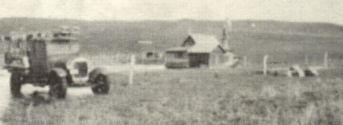HARVEY COTANT, THE WELL DRILLER
by Arthur E. Knutson, edited by Clair Knutson
Entry B14 from the History of Hooker County Nebraska
with permission of the Hooker County Historical Society

Harvey Cotant's Well Drilling Machine
Harvey Cotant was a well driller in the
Sandhills for 27 years - 1937 to 1964. He did
not develop the process he used but picked
up his skills from his predecessors. When
George Reddington, one of the best in the
business, passed away in 1937, Cotant built
his own rig and did very well, drilling 413
wells in those 27 years.
This drilling method, useable only in
country where there are no rocks such as in
the Sandhills, could be lost to history if not
explained. The owner of the property select-
ed the site for the new well. A stock water
tank was placed at the site and filled with
water using 50 gallon barrels hauled on a
wagon pulled by a two horse team from the
nearest source. The water hauling continued
throughout the entire drilling process.
A drill bit was formed by splitting the end
of a galvanized pipe into four sections using
about three inches of the pipe end. These
sections were heated in a forge and turned at
right angles to the pipe. The opposite end of
the three-foot length was threaded and
bushed down to fit the 1 1/4 drill pipe. Water
tight swivels were used to connect to the drill
rig so the pipe could be rotated 360 degrees
and yet permit a diaphragm pump, mounted
on the rig, to bring the water and loosened
sand up through the handmade drill bit and
the swivel as the bit sank into the ground. An
"A" frame tower erected directly over the
drill rig was rigged with a light block and
tackle which controlled the rate of descent of
the bit into the hole as too fast a feed could
overload the pump and the bit could plug,
necessitating the pulling of all the drill rods
for unplugging. Water was poured continu-
ally into the hole formed where the vertical
bit and drill rod combination was positioned
so that the bit dug deeper, the loosened sand
was carried in the water back up the pipe,
through the pump and deposited in sediment
piles connected by a hand dug ditch so that
as the water drained out of the materials it
flowed back into the hole to be used again.
The bit was turned using a pair of pipe tongs
clamped to the drill pipe at shoulder height.
An individual, or two people positioned
opposite to one another, walked in clockwise
circles to turn the pipe assembly, passing the
pipe tongs to the other at the half turn to
complete the rotation. As the bit sank into
the ground, the pipe clamp was raised to a
new position. When a ten foot section of drill
was worked down, the pump was thrown out
of gear, the swivel disconnected while anoth-
er section was installed and drilling was
resumed. Water pressure in the hole kept the
well sides from collapsing so once the well was
started there was no stopping until water,
sand and gravel was reached. The process
continued throughout the night on many
occasions.
The driller checked the courseness of the
sand and a sudden loss of water to indicate
a water bearing strata. Drilling was continued
past the water bearing strata to accommodate
the sand point placed directly at the bottom
of the well casing and the pump cylinder
directly above it, so as to allow the draw down
in the well and still keep the pump cylinder
always under water. The drill rod and bit
assembly was removed when the driller was
satisfied with the depth. The sandpoint,
cylinder, and well casing were then installed
and loose gravel was placed around the pipe
and allowed to settle over night before the
bottom check valve, screwed onto the upper
check valve by 1 1/2 turns which in turn was
securely screwed to the bottom of the pump
rods before being lowered into the well. The
lower check was securely seated at the bottom
of the cylinder and then the pump rod
assembly was turned two turns counter
clockwise to unhook the lower check from the
upper check which was raised to the pumping
location.
The new well was very carefully pumped
by hand to free it of debris and until clear
water reached the surface. A tower and
windmill were raised over the finished well,
connected and the forever blowing wind
finished the task of providing water.
